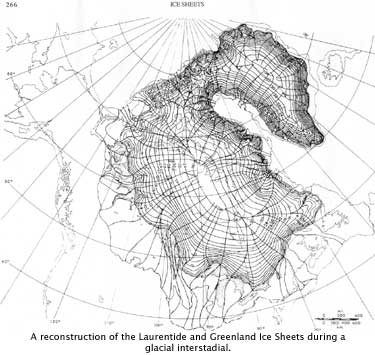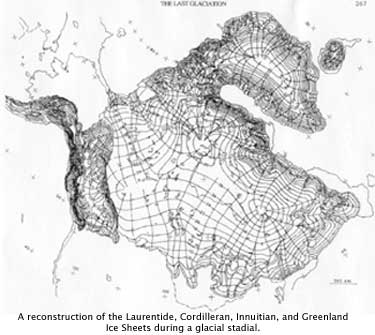Principal Investigators: Terence Hughes, James Fastook
This is a proposal to model the late glacial Laurentide Ice Sheet from its closest approach to steady-state equilibrium at ~25,000 BP (years before present), through reversible stadial-interstadial transitions associated with Laurentide iceberg outbursts (Heinrich events 2 and 11), and across the threshold of irreversible Laurentide collapse after the last iceberg outburst at ~11,000 BP (Heinrich event 0). The goals are to determine if these ice-sheet changes could have triggered climate changes on the timescale of abrupt ice sheet change, and to investigate the structure of any changes. The plan is to isolate mechanisms of abrupt change on the order of hundreds of years in the ice sheet that are large enough to trigger climate changes captured as time “snapshots” by our coupled global and regional atmospheric climate models. Specific modeling tasks are:
1.) To provide the climate settings surrounding the Laurentide Ice Sheet at "snapshots" of time during this late glacial period. This includes the wind field over the ice sheet as influenced by icesheet topography, the proglacial lakes bordering on the ice sheet, the fine-resolution mesoscale climate of North America, and global change. The state-of-the-art atmospheric models coupled for this project are the high-resolution limited-area ARCSyM developed for the Arctic and the global NCAR CCM3. The models will be influenced by the ice-sheet topography and provide the mass balance and temperature fields over the ice-sheet surface that are needed to compute the internal ice-sheet flow and temperature fields.

3.) To model the basal thermal, hydrological, and mechanical conditions within the imposed surface and basal boundary constraints for the chosen timeframe. Potential mechanisms of abrupt ice-sheet change to be modeled include surges of Laurentide ice streams that begin and end abruptly, episodes of rapid marine and lacustrine ice calving that begin and end abruptly, rapid restoration of interior ice elevations linked to wind fields over surrounding water bodies that can be overrun and restored abruptly, thereby turning off and on these nearby evaporation sources of ice-sheet precipitation, and marine or lacustrine thresholds of ice-margin instability that are linked to glacial isostatic adjustments and that lead to abrupt changes, including termination of the last glaciation cycle. All of these mechanisms are interrelated.

The proposed study has anticipated significance for educational outreach to students and for the possible behavior of present-day ice sheets. The anticipated education outreach program will be interactive with high school students. They will be able to manipulate the major variables discovered in our study so that they can view three-dimensional computer simulations, from any perspective, of how the Laurentide Ice Sheet responds to each variable. This program will be disseminated to students on the world-wide web. If fluctuations in the Laurentide Ice Sheet triggered climate changes, then the possibility exists that present-day ice sheets covering Greenland and Antarctica may be able to trigger similar climate changes, with all the social, economic, and political consequences. One way to assess this possibility is to understand the internal instability mechanisms that could have caused abrupt changes in Laurentide ice extent, and to tie them firmly to known late glacial climate changes. These are the goals of this proposal.
